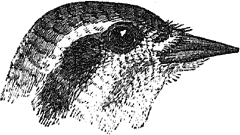|
Page 28 | prev page next page | ||
|
Subfamily PICUMNINAE This subfamily consists of the smallest forms of the group, distinguished by having flexible tail-feathers and short tails, by their nostrils being always covered with dense plumes and bristles, and, according to Mr. W. Kitchen Parker, by a less developed type of palatal structure. The Picumninae or Piculets, as they have been called, climb less and perch more than the true Woodpeckers, which, however, they resemble in food and in nidification. They are found in the Oriental region, Africa, and South America. Two genera are Indian.
Key to the Genera Genus PICUMNUS Temminck, 1825 Size small. Bill conical, compressed, pointed, the culmen slightly curved and angulate, nostrils and chin-angle concealed by dense plumes with black bristles projecting. Wing and tail rounded. Toes 4. Orbits feathered. Plumage soft, lax, and elongate. A large genus comprising 33 species, of which all but two are South American; one inhabits China, and one is Indian.
|
| ||
|
Coloration: Bill plumbeous black; irides brown; feet dark plumbeous (Scully). Male. Nasal plumes yellowish white, with black bristles projecting; forehead olive; sincipital feathers black with reddish-orange borders, occiput and hind neck olive; a broad band from the eye down, the side of the neck blackish olive; a malar stripe the same but mixed with white; two yellowish-white bands down each side of the neck, one from above the eye, the other below the eye and ear-coverts, and including the lores; back, scapulars, and rump bright yellow-olive; outside of wings the same, becoming duller on the coverts; inside of quills brown; yellowish white on the inner margins; tail blackish brown, inner webs of middle pair of feathers white, each feather of the two outer large pairs and the small outermost pair with a broad oblique white bar close to the tip; chin and throat white, breast and abdomen pale yellow, all with large black spots; flanks barred; wing-lining white. Female. The whole crown olive. Size: Length about 4; tail 1.4; wing 2.3; tarsus 0.52; bill from gape 0.5. Distribution: Throughout the Himalayas as far west as Murree, ranging from about 1500 to 6000, or even in places, according to Stoliczka, 9000 feet above the sea. This species has also been found very rarely in the hills of southern India near the west coast, by Mr. J. Darling in the Wynaad, and by Mr. W. Davison below Kotagiri on the Nilgiris. To the eastward it is found in Assam, Cachar, and Manipur, and very sparingly in Burma, the Malay peninsula, and Sumatra. In Burma it has hitherto only been recorded from Karennee by Wardlaw Ramsay, and from Tenasserim by Blyth and Bingham. Habits: According to Jerdon this bird is found in tangled brushwood and among dead and fallen trees in damp spots. Scully, however, observed it on trees near Katmandu. To the eastward it haunts bamboos. It feeds on various insects, and, according to Mr. R. Thompson, on the eggs and larva) of wood-boring beetles. It breeds in April and May, making a hole precisely like that of a typical Woodpecker, sometimes in the stem, sometimes in a branch of a tree, and laying usually three eggs, oval, whiter and very glossy, measuring on an average 0.6 by 0.5.
This genus of Piculets differs from Picumnus in wanting the first (inner hind) toe, and in having a naked space round each orbit, and a very short tail. The culmen is more rounded. The coloration, too, differs greatly from that of Picumnus. Three species are known - one is Himalayan and Burmese, the other two Malay.
Coloration: Upper mandible dark brown, lower plumbeous; iris crimson, orbits dusky red; legs yellowish red (Oates). Male. Nasal plumes and forehead golden yellow, the former terminating in long black bristles, the yellow shading into rufous on the sinciput; occiput and nape olive; lores light grey; a white supercilium carried back some distance from above the eye; back, scapulars, and edges of tertiaries rufous olive, remainder of outer surface of wing pure olive; rump bright orange-brown; quills (except the outer edges) brown with whitish inner margins; tertiaries pale brown; upper tail-coverts and tail black; lower parts orange-brown (brownish ferruginous), occasionally brownish yellow, sides of neck and hind neck rather more rufous; wing-lining yellowish white; edge of wing buff. In the female the forehead and sinciput are brownish rufous, like the hind neck. Size: Length 3.4; tail 1; wing 2.1; tarsus 0.55; bill from gape 0.55. Distribution: The Himalayas in Nepal, and further eastward; Assam, Tipperah, Sylhet, Cachar, Manipur, and throughout Burma, but not, so far as is known, farther south, this species being replaced in the Malay peninsula by S. abnormis. In Sikkim S. ochracea is found between 1000 and 6000 feet.
Habits: This little Woodpecker is usually solitary or in pairs; it
haunts brushwood and bamboos in forest, and, like Picumnus innominatus,
often makes its presence known by the noise it produces by tapping on
bamboos. It lives on various insects, partly, at all events, on Coleoptera.
Its eggs have been found in Sikkim by Mr. Gammie, amongst others, in June and
July. It makes a hole, sometimes in the stem of a tree, sometimes in a
bamboo. The eggs are white and measure about 0.63 by 0.5. | |||
| prev page :: next page | |||
 birding.in
birding.in
| Birds | Bird Diagram | Ornithology | Indian Sites | Bird Watching | Migration | North India | Birds of India | Haryana |
All rights reserved. Copyright © 2005-2013 Birds and birding in India. Disclaimer
website: Free Java Guide & Tutorials
